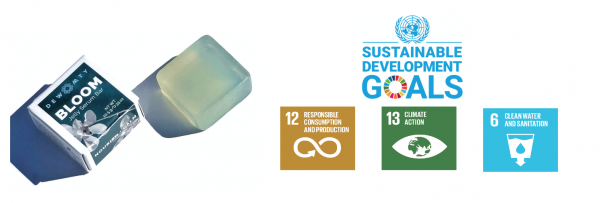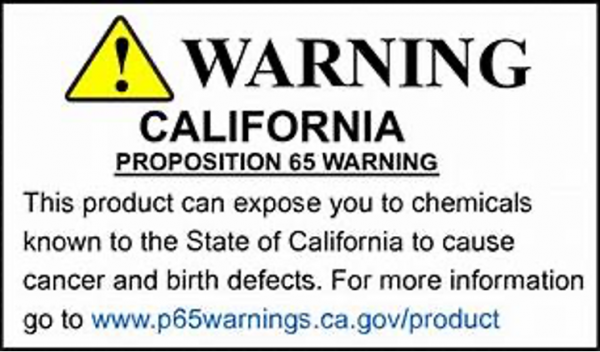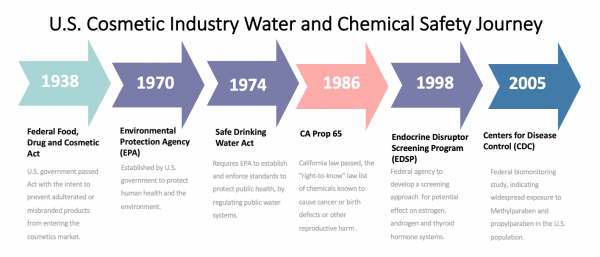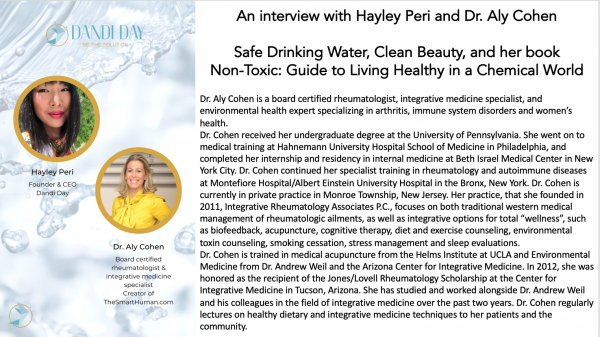Promotional Features
How Sustainability, Waterless, Water, and Chemical Safety Intersect
Introduction
As sustainability continues to take center stage, the market has seen increased demand to develop waterless formulations. The trend also brings to mind, reflections on ten years in the mid-2000's to early 2010s when waterless or anhydrous products emerged as the market shifted away from parabens. This article will touch on waterless products' sustainability aspects and dive into chemical safety through clean water. (Did you like our cheesy pun?) Congruently, we will discuss U.S. government, federal and state agencies, and significant events that contextualize where we are today in our sustainability journey through chemical safety.
Waterless Products, Water, and the UN SDGs
Waterless products made a big splash into the market with bath bombs, dry shampoo, shampoo, and conditioning bars. As recent as a solid skin serum by DEW Mighty. "This mighty multi-tasker can replace up to 8 products in a beauty routine without sacrifices on performance or our planet."i Less water means a more concentrated product and less weight in the shipping process with carbon footprint reduction and water conservation in mind. These strategies support two United Nations Sustainable Development Goals (UNSDGs or SDGs). SDG 12 - Responsible consumption and production patterns and SDG 13 – Climate action to combat climate change and its impacts. One SDG that does not receive as much sustainability limelight for our industry is SDG 6 – Clean water and sanitation to access safe drinking water, sanitation, and hygiene. U.S. policy initiated almost 50 years ago anticipated sustainability needs and aligned with SDG 6. So, formulations that require water still have the opportunity to participate in sustainability. Still, first, we need to understand the historical and current U.S. framework that supports clean water and sanitation.
The FDA and EPA
In 1938, the U.S. government passed the Federal Food, Drug and Cosmetic Act (FFDCA), giving the FDA authority to oversee the safety of food, drugs, medical devices, and cosmetics. The act's intent prevents adulterated or misbranded products from entering the cosmetics market through disclosures to identify the product, ingredient declarations except for fragrance or flavor ingredients, contaminants, or 'trade secrets,' disclosure of product net contents, display of any required warning labels.
Currently, the Safe Cosmetics and Personal Care Products Act of 2019 addresses some limitations of the FFDCA. It "is the only federal bill that holds cosmetic companies accountable for the safety of the ingredients in their products." [i]
- requires supply chain transparency and industry sharing of safety data
- closes the federal labeling loophole, specifically fragrances
- bans most animal testing
- tackles the "profuse exposure to toxic chemicals experienced by communities of color and professional salon workers."
The industry often discusses the FDA and FFDCA, and another federal organization known as the Environmental Protection Agency (EPA) significantly impacts the work of the U.S Cosmetics Industry.
The EPA, founded in 1970, protects human health and the environment by writing and enforcing regulations based on laws passed by Congress. They work with states, tribes, local governments, communities, and private organizations to ensure environmental law compliance.ii
The intersection of the FDA and the EPA as national organizations combined with state-level organizations and policies creates a baseline for environmental justice with water as the focal point.
Safe Drinking Water
The U.S congress Safe Drinking Water Act (SDWA), passed in 1974, protects public health. It requires the EPA to establish and enforce standards that public drinking water systems must follow. It also required EPA to delegate primary enforcement responsibility for public water systems to states and Indian Tribes if they meet specific requirements.iii Following the federal policy, in 1986, California voters approved an initiative to address concerns about exposure to toxic chemicals. That initiative became the Safe Drinking Water and Toxic Enforcement Act of 1986 - better known by its original name of Proposition 65. It requires California to publish a list of chemicals known to cause cancer, birth defects, or other reproductive harm. It also requires businesses to inform consumers about exposure to these chemicals. It was intended as a "right-to-know" law so people would have information about exposures to protect themselves if necessary.iv The list of chemicals covered by Prop 65 continues to grow as new scientific data becomes available. The law has been in effect since 1987. It applies to any business that exposes individuals within the state of California to one or more listed chemicals without providing a clear and reasonable warning.
Endocrine Disruptors and Parabens
In 1998 the Endocrine Disruptor Screening Program (EDSP) developed from a rare collaboration between the FDA and EPA. EDSP carried out the mandate in section 408(p) of the Federal Food, Drug, and Cosmetic Act (FFDCA) that requires the EPA to develop a screening program to determine whether certain substances may have an effect in humans similar to naturally occurring estrogen. Chemicals that mimic estrogen in the body can cause hormonal imbalances and negatively affect reproductive issues and cancer.
Drinking water, our food supply chain, and consumer goods are common exposure areas. Currently, EPA is managing the science-based EDSP that uses a two-tiered approach to screen pesticides, chemicals, and environmental contaminants for their potential effect on estrogen, androgen, and thyroid hormone systems. Parabens are an impactful example of the EDSP's work for the cosmetic industry.i A study in 2004 showed a correlation between endocrine disruption and parabens. However, the study is highly controversial in the industry. Since then, more studies have shown a correlation between endocrine disruption in humans and exposure to parabens. The culmination of the EPA's work, clean drinking water policy, EDSP, and the 2004 study revolutionized cosmetic formulations.
Formulation shifts, Waterless Products, and Preservation
The 2004 study on parabens came when companies had just begun reformulating products to replace ingredients of concern listed on Proposition 65.i In the mid-2000s, parabens were the most commonly used preservative in cosmetic formulations. They function to protect a formulation from the growth of microorganisms such as yeast, mold, bacteria, and fungus. These microorganisms need water to grow, and without a viable replacement to parabens, the market demand for paraben-free products caused a surge of waterless or anhydrous product development. U.S. chemists soon adopted European ingredients and formulation strategies that met regulatory requirements similar to Proposition 65. Popular parabens alternatives include phenoxyethanol, caprylyl glycol, sodium levulinate, sodium anisate, and caprylhydroxamic acid. Today more preservation options are available, and waterless products have a multi-purpose place in the market. As we now know, the movement to "clean" formulations and brands to reduce exposure to ingredients and chemicals that cause cancer, birth defects, reproductive harm, including endocrine disruptors, set the precedence for the next generation of formulation development.
Sustainability, Chemical Safety, and Exposure
Long-term and generational human health effects from environmental exposure to low levels of parabens and other endocrine disruptors are unknown. Biomonitoring is an emerging field of study of the environment and public health that helps us understand.
- environmental chemicals exposed to people
- the amounts of chemicals in people's bodies
- people's nutrition status by measuring indicators such as iron and folate
Measurements improve the detection, diagnosis, treatment, and prevention of disease, injury, and harmful exposures in populations.ii U.S. federal agency, Centers for Disease Control and Prevention (CDC) issued the first national report on human exposure in 1996, revealing concentrations of more than 100 compounds in the U.S. pollution. A study from 2005 to 2006 reported Methylparaben and propylparaben in the urine of most of the people tested. The measurements found indicate widespread exposure to these parabens.iii
- In adults younger than age 60, non-Hispanic blacks had higher levels of methylparaben than non-Hispanic whites.
- Females had several-fold higher concentrations of methylparaben and propylparaben than males. Which likely reflects the greater use of products containing parabens.
As we consider exposure to chemicals and work in collaboration with emerging science, chemical safety continues to be a key area of sustainability.
Conclusion:
The global focal point on climate change and conservation moves the industry to employ sustainable strategies such as waterless products. It also reminds us that chemical safety policy is a clear sustainability strategy for clean water and sanitation. California led the U.S. industry as an innovation hub. The early adopters of safe drinking water policy and a culture that prioritizes chemical transparency have set the market pace. A focus on SDG 6 for clean water and sanitation also sets the industry's precedence and trajectory to participate in environmental and social justice. As new scientific research and work at the governmental level transpire, collaboration at all levels is needed more than ever.
-----
References:
i. UNBOTTLED, UNDILUTED, UNCOMPLICATED SLOW ... - DEW MIGHTY. https://www.dewmighty.com/ii. Cosmetic Safety: 82 years later, have things changed .... https://www.bcpp.org/cosmetic-safety-82-years-later-have-things-changed/iii. EPA History. EPA, Environmental Protection Agency, https://www.epa.gov/history.iv. “Overview of the Safe Drinking Water Act.” EPA, Environmental Protection Agency, https://www.epa.gov/sdwa/overview-safe-drinkingwateract#:~:text=The%20Safe%20Drinking%20Water%20Act%20%28SDWA%29%20was%20originally,sources%E2%80%94rivers%2C%20lakes%2C%20reservoirs%2C%20springs%2C%20and%20ground[1]%20water%20wells.v. “Safe Drinking Water and Toxic Enforcement Act of 1986 - Proposition 65.” Oehha.ca.gov, https://oehha.ca.gov/proposition-65.vi. http://oehha.ca.gov/prop65.htmlvii. Endocrine Disruptor Screening Program (EDSP) Overview | US EPA. https://www.epa.gov/endocrine-disruption/endocrine-disruptor-screening-program-edsp-overviewviii. Darbre PD;Aljarrah A;Miller WR;Coldham NG;Sauer MJ;Pope GS; “Concentrations of Parabens in Human Breast Tumours.” Journal of Applied Toxicology : JAT, U.S. National Library of Medicine, https://pubmed.ncbi.nlm.nih.gov/14745841/.ix. “Biomonitoring.” Biomonitoring - an Overview | ScienceDirect Topics, https://www.sciencedirect.com/topics/earth-and-planetary-sciences/biomonitoring.x. Parabens Factsheet | National Biomonitoring Program | CDC. https://www.cdc.gov/biomonitoring/Parabens_FactSheet.html***A special thanks to Dr. Nicole Acevedo for review and collaboration on the article***








